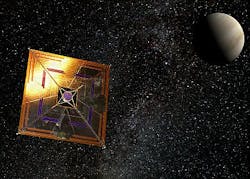NASA looks for companies able to build solar sails for pushing CubeSats through deep space
HUNTSVILLE, Ala., 30 Oct. 2013. U.S. spacecraft researchers are reaching out to industry to fond companies able to design and build solar sails deployable from a tiny spacecraft measuring just 64 cubic inches that will be built for deep-space exploration.
Solar-sail spacecraft propulsion uses radiation pressure from stars to push large ultra-thin mirrors to high speeds. Essentially it uses starlight instead of wind to propel spacecraft.
Researchers from the NASA Marshall Space Flight Center in Huntsville, Ala., have issued a sources-sought notice (NNM14ZPS001L) for the CubeSat Solar Sail Systems program, which seeks companies able to build solar sails as large as 33 by 33 feet that are deployable from CubeSats as small as 4 by 4 by 4 inches.
A CubeSat is a type of miniaturized satellite for space research that usually has a volume of about one quart, weighs about 3 pounds, and that uses commercial off-the-shelf (COTS) electronic components. NASA researchers are considering CubeSats containing test instruments and perhaps even tiny robots for deep-space research.
NASA Marshall experts are interested in solar sail systems for interplanetary robotic exploration that may be deployed from a CubeSat that may be delivered for flight as soon as 2016.
The solar sail must be capable of deployment after the CubeSat separates from the launch vehicle, and be made from a reflective sail membrane, a deployable sail support structure, an independent sail actuation system, and hardware and software necessary to prepare the sail for launch. The solar sail's actuation system may be coupled to the CubeSat attitude control system to minimize or eliminate the use of propellant.
NASA researchers want the solar sail's membrane to be made from a space-durable, tear-resistant or tear-tolerant material with an operational lifetime of at least two years in deep space that may include operations at or near the Moon. The solar sail also may be used as a solar reflector to provide lighting.
Companies interested should email responses no later than 4 Nov. 2013 to NASA's Marlyce Alexander at [email protected]. For questions or concerns phone Marlyce Alexander at 256-544-8344, or contact NASA's Belinda Triplett by phone at 256-961-7650 or by email at [email protected].
More information is online at https://www.fbo.gov/spg/NASA/GMSFC/POVA/NNM14ZPS001L/listing.html.

